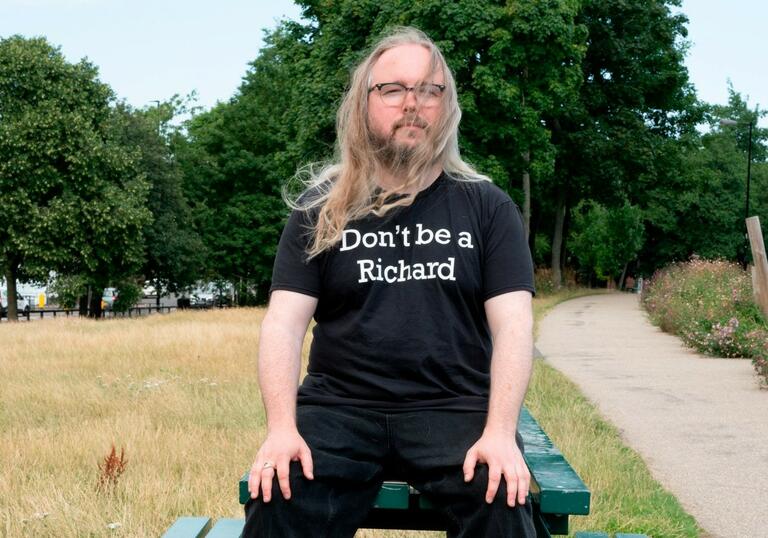Richard Dawson - digital programme notes

Mike Barnes sits down with cult folk figure Richard Dawson, discussing the inspiration behind his music ahead of his highly anticipated Hall debut.
Richard Dawson is one of the UK’s most original singer-songwriters. His singular musical and lyrical approach resists an easy categorisation – he has an out-of-timeness that feels both ancient and forward-looking. Writers have called it ‘folk-flavoured’, ‘freak folk’, ‘progressive folk’ and the rather paradoxical category, ‘avant-garde folk’. But there’s a lot more to it than even those labels would imply.
‘I never really knew about folk music until I was in my 30s,’ he says. ‘I’d heard bits and bobs, but no more than anything else. I was more coming from rock and metal when I was a teenager. My sister had a bunch of Iron Maiden records, and that was my first love.’
He also began delving into his local record library in Newcastle and borrowed albums by artists such as Malian guitarist Ali Farka Touré – ‘I didn't really get it, but I was fascinated by it’ – the Qawwali singer Nusrat Fateh Ali Khan, who he describes as ‘mind blowing’. ‘From the age of 16, I was drawn to more experimental and avant-garde music,’ he recalls. ‘I always wanted to hear something new.’
Dawson recorded his debut album in 2007 and his increasingly imaginative approach has peaked on the series of albums that began with 2017’s Peasant, which explores Britain in the Dark Ages, after the Romans had left and society was in flux. It was followed by an examination of modern times in 2020, which came out in 2019. Released last year, The Ruby Cord is probably, although not definitely, the final chapter in this trilogy and is set in the future.
‘It's all linked,’ Dawson explains. ‘They seem far apart, but that's just our viewpoint, because of how we experience time. But that is only one version of it. If you were to zoom out, these moments are very close to each other.’
The songs on The Ruby Cord were partly inspired by the enforced introspection of lockdown. In it, Dawson examines technological advances and the construction of fantasy worlds and how they affect people’s relationships and perceptions, and wonders what the next stage might be. Can he describe The Ruby Cord’s futuristic world of virtual, or augmented, reality?
‘I don't know if I would want to describe it,’ he replies. ‘Because hopefully, there's enough in the album, in terms of what's pinned down, and then suggestions of different paths that people might be able to take and create their own worlds from listening to it.’
Dawson describes his creative process as ‘stumbling across’ new musical ideas in practice sessions and absorbing influences from films, books and other music.
‘By the time I'm ready to write the lyrics, I'll have a fair idea of what it is I want to do,’ he explains. ‘And I tend to then approach it like office work, nine to five. That’s the only way I can get through it because I'm not a fast writer and I don’t write all the time. If I wrote four lines in a day, that would be an unbelievably great day.’
Half of The Ruby Cord is taken up by ‘The Hermit’, which weighs in at a challenging 41 minutes.
‘It's that long, because it has to be,’ Dawson says. ‘The story needs that time to unfold. It’s intrinsic to the character, the pacing of it, and the detail, because the song is all about perceptions, your perception, but also people's perception of you, and the effects those kinds of things can have.’
The cinematic unfurling of the narrative makes ‘The Hermit; particularly compelling, and like many of Dawson’s songs on The Ruby Cord, the journey is far from linear and the narrative perspective can shift to disorientating effect.
‘I really love films, and the language of camera movement and editing, and so I bring in some of that kind of approach,’ he says. ‘But I think it's important that there's a strong narrative and that I know the story. But like any story, the truest way to tell it isn't always the clearest way. Things are rarely clear. They can be confused and foggy and difficult to grasp.’
As well as his solo work, Dawson has collaborated with a wide range of musicians, including the Finnish mesmeric metal band Circle, and has recorded in the boisterous electronic pop combo, Hen Oggled. The Ruby Cord is musically diverse and moves through a number of styles – from plaintive songs and folky chorales – to rock and free-form passages. Dawson has an unusual guitar technique with his instrument ‘strung really low’ and his live band comprises his partner Sally Pilkington on vocals and keyboards, with Angharad Davies on violin, drummer Andrew Cheetham and harpist Rhodri Davis, all of whom have considerable experience as improvisers.
‘On a practical level, they're really well-trained musicians, technically astounding, so they can do it all,’ Dawson enthuses. ‘There's a lot of precise stuff that I need them to do, but they're all adventurers as well and there's a lot of room for improv and for the music to really flex and billow.’
Details
Performers
Richard Dawson acoustic guitar, lead vocals
Sally Pilkington synth, backing vocals
Angharad Davies violin, backing vocals
Rhodri Davies harp, backing vocals
Andrew Cheetham drums
